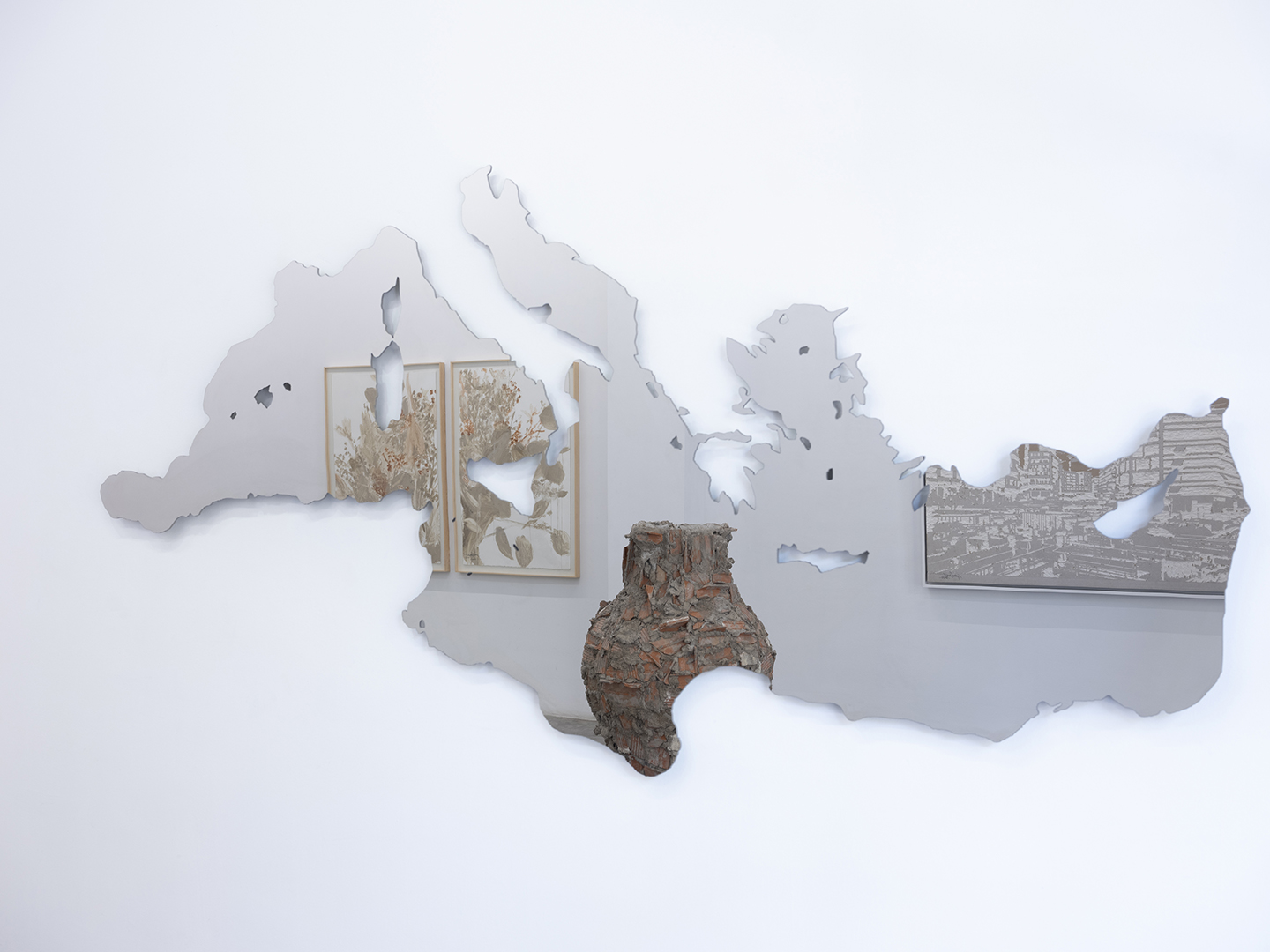États limites – Jean Denant

États limites – Jean Denant
“Arriving at each new city, the traveler finds again a past of his that he did not know he had: the foreignness of what you no longer are or no longer possess lies in wait for you in foreign, unpossessed places.”
― Italo Calvino, Invisible Cities, 1974.
For Jean Denant, the gesture that derives from his architectural thinking is a primordial element with which to sense his work, as he uses this gesture to draw us back to our own existence. His works question humankind through architecture, by making use of architectural materials, in order to dissipate the boundaries between disciplines and raise questions about our reality, thus encouraging us to gravitate towards a poetic sensibility.
In his latest project for RocioSantaCruz, the paintings reveal landscapes made with cement, images turn into stories, border munitions become beads for titanic necklaces, and the rubble of extermination sites are transformed into receptacles of life.
États limites alludes to the organization of those territories that, being imagined or real, nourish each other, highlighting the porous fragility of borders, be they psychological, geographical or political. Borders that are essentially turning points where flows change direction, social constructions – fences, passports, maps… – that are not meant to prevent things from moving, but act as symbols of movement itself.
Once again, Denant uses cement, brick or stone to bring us closer to those sites, in which exchange functions as a poetic metaphor that emerges from the tangible and moves towards the symbolic, navigating between subjectivity and that which is common to us all. An exercise in spatialisation that brings us back to a specific way of observing the world, that which emerges from the border, from that place where a myriad of phenomena (political, psychological, cultural, economic…) are most profoundly unveiled.
As Jacques Derrida pointed out in an interview conceded in 1986, “if each language suggests a spatialisation – a certain disposition in a space that cannot be mastered but is only accessible by successive approximations – then it is possible to compare it to the opening of a path. A path not to be discovered but to be created. And architecture is by no means alien to such creation. Every architectural space, every habitable space, starts from a premise: that the building is on a path, at a crossroads where it is possible to leave and return. There is no building without paths leading to it or starting from it, nor are there buildings without interior routes, without corridors, staircases, passageways, halls or doors”. (1)
In fact, the photograph États limits main – pierre (2022) serves as a gateway, an inner passage into the exhibition, into the ambivalence of an encounter and a disagreement, into the contrast between the human and the mineral, into the borderline states where extreme symbolic universes are evoked whilst touching each other.
With the imposing Mare Nostrum, a living work that is nourished by the passage of light through its polished stainless steel surface, the author places us in the Mediterranean. By following its relief of an inland sea, from the Latin (medi terraneum) ‘in the middle of lands’, an ecumenical space, permanently populated by different cultures (the ‘Mare Nostrum’ of Ancient Rome, the ‘Thalassa’ of the Greeks or the ‘Great Green’ of the Ancient Egyptians), he forces us to orientate ourselves inversely, to dis-orientate ourselves, while we recognise our own image in its reflection. Mare Nostrum, appeals to an imaginary of multiple narratives that in turn incite a sense of political anguish. A geo-cultural ensemble whose coordinates change according to historical time and in accordance with the rhythms of memory, in defiance of the established rules and the entrenched discourses that turn it into a mere frontier between continents, a large cemetery or a multiform neighborhood. A neighborhood that, as the landscapes of Palestine depicted with cement on paper reminds us, may find the same horizon in its fragile and unstable multiplicity.
The presence of the different cultures that characterize the Mediterranean region is represented as a true “multiverse of civilisations”. And from the exchange of their symbolic universes we are able to retrieve commercial allegories such as those embodied in the amphorae, evoked in the oversized Amphore (2022); or to unearth common vestiges, both mythological and contemporary, as the necklaces in the series Collier, la guerre de pierres (2022) recall. Colossal ornaments made from cement molds of the stones that serve as ammunition for the border slingshots in Gaza.
Ammunition to embellish and adornment to attack, limits to cross, and symbols to be re-signified, borderline states of a world that is constructed and deconstructed in perpetuity, a project whose architecture is made and unmade like Penelope’s tapestry, with which recollection entails the possibility of a comeback.
(1) «Architetture ove il desiderio può abitare» interview by Eva Meyer in February 1986, Domus, 671, April 1986, pp. 16-24 (includes an English translation). In DERRIDA, J, No escribo sin luz artificial, Cuatro ediciones, Valladolid, 1999. pp. 133-140.
Press:
- Jean Denant. El Territori com a recurs creatiu. Ramón Casalé Soler. El Temps de les Arts. 04.10.2022
Con el apoyo de / Amb el suport de / With the collaboration of

